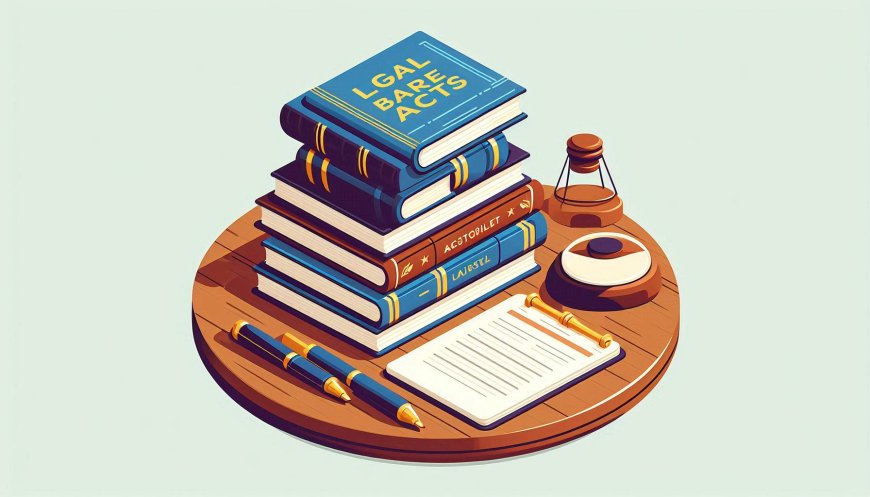How to Read Bare Acts for Beginners: A Step-by-Step Guide
Whether you're preparing for competitive exams or trying to build a strong legal foundation, this guide, along with reliable resources like the LexisNexis book store, will help you get started.

Reading a bare act can feel overwhelming, especially for law students, judiciary aspirants, or anyone new to legal studies. The language is technical, the structure formal, and the absence of commentary can make it hard to follow. But understanding bare acts is essential for mastering the law. This blog offers a simple, step-by-step approach to help beginners read bare acts effectively.
Whether you're preparing for competitive exams or trying to build a strong legal foundation, this guide, along with reliable resources like the LexisNexis book store, will help you get started.
What is a Bare Act?
A bare act is the exact text of a law as passed by the legislature, without any commentary, explanation, or interpretation. It contains the sections, subsections, schedules, definitions, amendments, and the original language of the statute.
Think of it as the “raw law” – unfiltered and unaltered.
Why Reading Bare Acts is Important
-
It builds a strong conceptual understanding of the law.
-
It helps in developing precision in legal interpretation.
-
It’s essential for the judiciary and UPSC law optional preparation.
-
It aids in decoding statutory language used in court.
Step-by-Step Guide: How to Read Bare Acts
1. Start with the Short Title and Preamble
Every bare act begins with a short title, extent, and commencement. This tells you:
-
What the act is called
-
Where it applies
-
When it came into force
The preamble gives insight into the objective and purpose of the act.
2. Understand the Definitions Section
Next, read the “Definitions” section carefully (usually under Section 2). Many terms in the act have specific meanings different from their general usage. Keep referring back to these as you read further sections.
3. Break Down Each Section Slowly
Don’t rush. Read one section at a time and:
-
Identify the subject
-
Note the conditions or exceptions
-
Understand the scope and applicability
Underline key phrases and make margin notes if needed.
4. Pay Attention to Provisions and Exceptions
Words like "provided that", "notwithstanding anything contained", or "subject to" indicate exceptions or conditions. These can change the meaning of the entire section, so treat them as crucial.
5. Use Reliable Editions from LexisNexis Book Store
To avoid outdated or incomplete texts, always choose authentic publishers. The LexisNexis book store offers up-to-date, well-formatted bare acts with accurate footnotes, recent amendments, and sometimes marginal notes to ease navigation.
6. Refer to the Index or Table of Contents
Most beginners ignore the index, but it helps map the structure of the act. Knowing where each part, chapter, or schedule starts makes the reading more organised.
7. Create a Reading Plan
For long acts like the Constitution of India or the IPC:
-
Divide the reading over weeks
-
Set a fixed number of sections per day
-
Make short summaries after each reading session
8. Use Supplementary Resources (But Only After First Reading)
Only after reading the bare act once should you refer to:
-
Commentaries
-
Case laws
-
Video explanations
These help clarify interpretation, but your first impression should come directly from the act.
9. Highlight Amendments and Updates
Many laws are amended frequently. Always check the latest edition or use an updated digital version from the LexisNexis bookstore. These versions usually mention the date and number of the amending act in the footnotes.
10. Practice Interpretation Through Questions
Test yourself by answering previous year questions or explaining a section in your own words. This reinforces understanding and reveals gaps in reading.
Common Mistakes to Avoid
-
Memorising without understanding
-
Ignoring marginal notes or headings
-
Skipping sections that seem “boring”
-
Reading outdated editions
Final Thoughts
Reading a bare act is a skill that develops with time and practice. Don’t get discouraged by legal jargon or complex sentence structures. Start slow, build consistency, and rely on quality editions from the LexisNexis bookstore to guide your journey.
Once you master reading bare acts, you'll find the aw much more approachable and logical. It’s the foundation of legal knowledge and a must-have tool in every law aspirant’s toolkit.
What's Your Reaction?
 Like
0
Like
0
 Dislike
0
Dislike
0
 Love
0
Love
0
 Funny
0
Funny
0
 Angry
0
Angry
0
 Sad
0
Sad
0
 Wow
0
Wow
0































